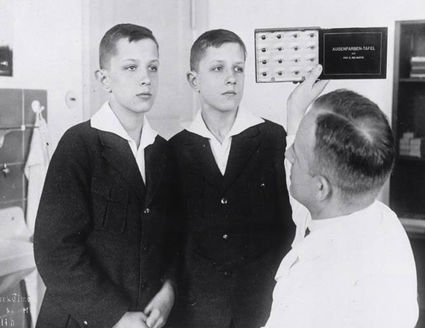'Deadly Medicine: Creating the Master Race' opens at HMREC
June 22, 2018

courtesy of the US Holocaust Memorial Museum-Archiv zur Geshichte der Max-Planck-Gesellschaft, Berlin-Dahlem
Dr. Otmar von Verschuer examines twins at the Kaiser Wilhelm Institute's Department for Human Heredity. Verschuer, a physician and geneticist, examined hundreds of pairs of twins to study whether criminality, feeble-mindness, tuberculosis, and cancer were inheritable. In 1927, he recommended the forced sterilization of the "mentally and morally subnormal." Verschuer typified those academics whose interest in Germany's "national regeneration" provided motivation for their research.
The United States Holocaust Memorial Museum's traveling exhibition "Deadly Medicine: Creating the Master Race" examines how the Nazi leadership, in collaboration with individuals in professions traditionally charged with healing and the public good, used science to help legitimize persecution, murder, and ultimately, genocide.
The exhibition opened at the Holocaust Center on June 17 and will be on display through Aug. 31, 2018. The Center will celebrate with an opening reception on Sunday, June 24 from 2-4 p.m., with guest speaker Robert Tanen, director of the U.S. Holocaust Memorial Museum's Southeast region. Members of the exhibit committee will be on hand to answer questions and engage in relevant dialogue. The committee is comprised of local leaders in areas of: anthropology, genetics, medicine, law, and spiritual leaders.
This is a unique experience to have these experts on hand and available for discussion as exhibit attendees explore these themes throughout the exhibition.
"Deadly Medicine explores the Holocaust's roots in then-contemporary scientific and pseudo-scientific thought," explained exhibition curator Susan Bachrach. "At the same time, it touches on complex ethical issues we face today, such as how societies acquire and use scientific knowledge and how they balance the rights of the individual with the needs of the larger community."
Eugenics theory sprang from turn-of-the-20th-century scientific beliefs asserting that Charles Darwin's theories of "survival of the fittest" could be applied to humans. Supporters, spanning the globe and political spectrum, believed that through careful controls on marriage and reproduction, a nation's genetic health could be improved.
The Nazi regime was founded on the conviction that "inferior" races, including the so-called Jewish race, and individuals had to be eliminated from German society so that the fittest "Aryans" could thrive. The Nazi state fully committed itself to implementing a uniquely racist and antisemitic variation of eugenics to "scientifically" build what it considered to be a "superior race." By the end of World War II, six million Jews had been murdered. Millions of others also became victims of persecution and murder through Nazi "racial hygiene" programs designed to cleanse Germany of "biological threats" to the nation's "health," including "foreign-blooded" Roma and Sinti (Gypsies), persons diagnosed as "hereditarily ill," and homosexuals. In German-occupied territories, Poles and others belonging to ethnic groups deemed "inferior" were also murdered.
This exhibition from the US Holocaust Memorial Museum was made possible by the support of The David Berg Foundation, The Blanche and Irving Laurie Foundation, The Lester Robbins and Sheila Johnson Robbins Traveling and Temporary Exhibitions Fund established in 1990, and The Dorot Foundation.



Reader Comments(0)